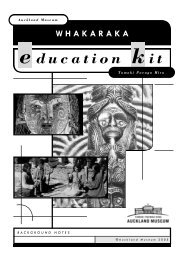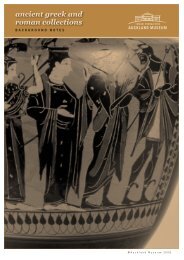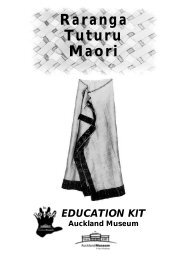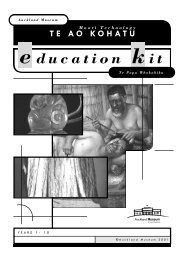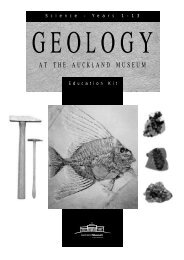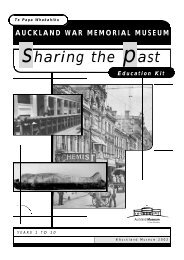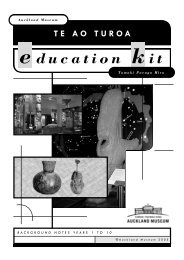Tukutuku Tuturu Maori - Auckland Museum
Tukutuku Tuturu Maori - Auckland Museum
Tukutuku Tuturu Maori - Auckland Museum
Create successful ePaper yourself
Turn your PDF publications into a flip-book with our unique Google optimized e-Paper software.
Nihotaniwha: The Teet h of the<br />
Dragon<br />
Taniwha are mythical monsters<br />
usually associated with the<br />
ocean, lakes and rivers of New<br />
Zealand. Feared for the<br />
destruction they wrought, their<br />
sharp diamond pointed teeth are<br />
symbolised by this design.*<br />
The persistency of the "taniwha"<br />
stories throughout <strong>Maori</strong>dom is<br />
now decreasing, but try to<br />
picture the scene of old. The<br />
dying embers in the<br />
Meetinghouse at night, the<br />
how ling w ind and the pelting<br />
rain--these were the atmosphere<br />
for such stories, and the lively<br />
mind of the listener filled in the<br />
gaps. The slaughter by the dread<br />
monster, the trembling and<br />
fearful planning for revenge, the<br />
luring of the taniw ha, the<br />
baiting, the attack, the kill - and<br />
suddenly the heavens w ithout<br />
are rent by jagged lightening<br />
and thunder!**<br />
Kao kao: Human Ribs-Armpits<br />
© 1997 <strong>Auckland</strong> <strong>Museum</strong><br />
Abstraction and symbolism, to<br />
the point where the human<br />
element is difficult to recognise,<br />
represents the interfusion of the<br />
spiritual and temporal life of the<br />
<strong>Maori</strong>.*<br />
This pattern was dedicated to<br />
the war-god, Tumatauenga. By<br />
placing the pattern upside down,<br />
we obtain the (military) chevron,<br />
signifying promotion in rank<br />
(the kaokao sentiment of<br />
"discernment, decision and<br />
design"). Prior to setting out on<br />
a war expedition, all the warriors<br />
were made to step on a takapau<br />
(mat) with the kaokao pattern,to<br />
inspire them. The open armpit<br />
distinguishes the warrior<br />
(signif ying a raised arm ready<br />
for battle). The closed armpit,<br />
the weak and frightened one<br />
huddled in fear.**<br />
Waamu or Mumu and<br />
Whanganui Mumu<br />
Almost a draught-board effect of<br />
patterns arranged to produce a<br />
diagonal sequence and<br />
(sometimes) used with purapura<br />
whetu,kaokao,poutama,<br />
roimata… designs. A mumu<br />
gives a lightening and pleasing<br />
effect to an otherw ise<br />
dark recess. The<br />
Whanganui people<br />
brought out the<br />
mumu to advantage<br />
by dividing the panel<br />
into three equal<br />
vertical sections, and<br />
by the judicious<br />
employment of the<br />
above patterns,made<br />
a great contribution<br />
to interior<br />
decoration. Their<br />
meeting house at<br />
Putiki, Te<br />
Pakuoterangi, is a<br />
striking w itness to<br />
this. Its significance<br />
is that of<br />
combination; applied<br />
inter-tribally, it<br />
denotes intermarriage<br />
between<br />
senior families.**<br />
6



